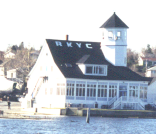
|
SE4083 - Hydrographic Field Operations 2000 the class of SE4083-2000
|

|
SE4083 - Hydrographic Field Operations 2000 the class of SE4083-2000
|
Overview
A hydrographic, oceanographic and geophysical survey was executed in
May 2000 as part of SE4083 - Hydrographic Field
Operations. SE4083 is a 4th year undergraduate course offered within
the Dept. of Geodesy and Geomatics Engineering at UNB as part of the specialisation
in Ocean Mapping. The aim of the course is to expose the students to the
practical issues involved in the planning, execution and processing involved
in a coastal marine survey.
Area of Interest
The Kennebecasis had last been surveyed for Hydrographic purposes in
the 1930's. Whilst upstream sections of the river had been surveyed in
the early 90's (using conventional single beam technology), the Kennebecasis,
with its greater depths and non-existant commercial traffic had not been
a high proirity for resurvey. We thus had the opportunity to gh proirity for resurvey. We thus had the opportunity to provide a
useful bathymetric survey of an area that is actually used extensively
by the local recreational yachting community. In addition, as demonstrated
below, the area was one of high oceanographic and geologic variability
and thus served as an excellent training model to introduce the students
to environmental and geophysical survey applications.
Survey Platforms and Instrumentation
The survey was carried out using two platforms:
Survey Design
Survey Execution
The Plover was used for the first 5 days to cover the 10m+ depth area
of the basin and to explore the channels discoverd to the west (see below).
The Knudsen was then used for 10 days with a fixed 20m line spacing oriented
orthogonal to the long axis of the Kennebecasis.
Tidal control was obtained from a CHS tide gauge temporarily mounted on the edge of the RKYC dock. The gauge elevation was levelled to a local geodetic datum marker ~ 1km away by the students of the Survey Camp II class under the guidance of Howard Biggar.
EM3000 survey results
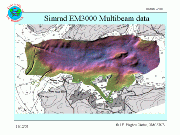 |
The EM3000 survey extended from the sill at Grand Bay to just NE of
the entrance to Milkish channel. 200% multibeam coverage was obtained for
most areas, and transit lines in and out of Brothers Cove were compiled
to build up a picture of this shallow embayment. Using the OMG/UNB
Sunb.ca/~jhc/SwathEd.html">SwathEd
software, the data were merged with tide and navigation, edited,
gridded and mosaicked on a daily basis by the students themselves.
A number of particularily interesting features were noted: |
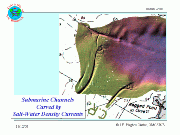 |
Submarine Channels
On the flanks of the sill, at the SW end of the Kennebecasis, large erosionally scoured channels were identified from the multibeam survey. No indication of these channels exists from the historic hydrographic data (although, given that it was a lead line survey, this is hardly surprising!). As part of a foart of a follow-on Oceanographic study of the sill conducted later in June, July and October, it became apparent that these channels are carved by salt water density flows that are generated as the flood tide lifts the halocline over the sill. |
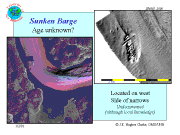 |
Wreck in Reversing Falls approaches
A third wreck was noted, during transit through the gorge immediately upstream of the reversing falls. Again this wreck is not reported on the chart. It lies in 20-30m of water, and is ~60m long. Local knowledge suggests that this is a sunken barge. The transit lines through the gorge were compile to produce a single
bathymetric image of the Reversing
Falls itself....
|
Knudsen sidescan imaging results
Knudsen 28 kHz subbottom imaging results
Knudsen 200 kHz downlooking imaging of the halocline
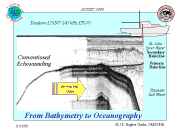 |
For every second Knudsen line, the 200 kHz channel was diverted to
the downward looking 6 degree transducer. The power and gain levels were
set to maximise the visibility of the in-water column scatterers. The halocline
was apparent for the entire survey, with a slowly changing character. Large
perturbation of the thermocline at this time wetion of the thermocline at this time were not, however, noticed
in the May survey. This was probably due to the high spring freshet (~3-5m
over datum during the survey) which depressed the halocline and prevented
influx of new salt water from the ocean on the flood tide.
Later studies of this phenomena, however, in June, July and October as part of a follow-on Oceanographic study of the sill revealed much more variability and detail. |
Instructor
John E. Hughes Clarke
Technical Support
Howard Biggar
Jerry Zhang
Teaching Assistants
Edouard Kammerer - EM3000 operator
Graham Nickerson - Knudsen operator
Anya Duxfield - SwathEd demonstrator
Anders Akerberg
Jill Coles
Rob Tremblay
John Winistok